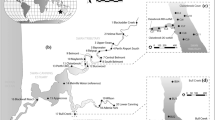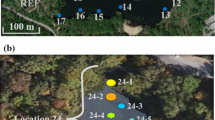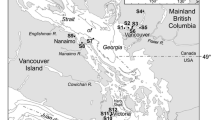Abstract
The sediments in the Calcasieu Estuary are contaminated with a wide variety of chemicals of potential concern (COPCs), including heavy metals, polycyclic aromatic hydrocarbons, polychlorinated biphenyls, phthalates, chlorinated benzenes, and polychlorinated dibenzo-p-dioxins and dibenzofurans. The sources of these COPCs include both point and non–point source discharges. As part of a baseline ecological risk assessment, the risks to benthic invertebrates posed by exposure to sediment-associated COPCs were assessed using five lines of evidence, including whole-sediment chemistry, pore-water chemistry, whole-sediment toxicity, pore-water toxicity, and benthic invertebrate community structure. The results of this assessment indicated that exposure to whole sediments and/or pore water from the Calcasieu Estuary generally posed low risks to benthic invertebrate communities (i.e., risks were classified as low for 68% of the sampling locations investigated). However, incremental risks to benthic invertebrates (i.e., compared with those associated with exposure to conditions in reference areas) were indicated for 32% of the sampling locations within the estuary. Of the three areas of concern (AOCs) investigated, the risks to benthic invertebrates were highest in the Bayou d’Inde AOC; risks were generally lower in the Upper Calcasieu River AOC and Middle Calcasieu River AOC. The areas showing the highest risks to sediment-dwelling organisms were generally located in the vicinity of point source discharges of COPCs. These results provided risk managers with the information required to make decisions regarding the need for remedial actions at the site.











Similar content being viewed by others
References
American Society for Testing and Materials (2009a) Guide for collection, storage, characterization, and manipulation of sediments for toxicological testing and for selection of samplers used to collect benthic invertebrates (ASTM E1391-03R08). In: Annual book of ASTM standards, vol 11.06. West Conshohocken, PA
American Society for Testing and Materials (2009b) Standard guide for designing biological tests with sediments (ASTM E1525-02R08). In: Annual book of ASTM standards, vol 11.06. West Conshohocken, PA
American Society for Testing and Materials (2009c) Standard test method for measuring the toxicity of sediment-associated contaminants with estuarine and marine invertebrates (ASTM E1367-03R08). In: Annual book of ASTM standards, vol 11.06. West Conshohocken, PA
American Society for Testing and Materials (2009d) Standard test methods for measuring the toxicity of sediment-associated contaminants with freshwater invertebrates (ASTM E1706-05E01). In: Annual book of ASTM standards, vol 11.06. West Conshohocken, PA
Barrick R, Becker S, Pastorok R, Brown L, Beller H (1988) Sediment quality values refinement: 1988 update and evaluation of Puget Sound AET. Prepared by PTI Environmental Services for Environmental Protection Agency, Bellevue, WA. http://www.ecy.wa.gov/biblio/0609094.html. Accessed September 2010
Brown SS, Gaston GR, Rakocinski CF, Heard RW (2000) Effects of sediment contaminants and environmental gradients on macrobenthic community trophic structure in Gulf of Mexico estuaries. Estuaries 23:411–424
Canadian Council of Ministers of the Environment (CCME) (1999) Canadian environmental quality guidelines. Guidelines and Standards Division, Environment Canada, Winnipeg, Manitoba. http://ceqg-rcqe.ccme.ca/. Accessed September 2010
Carr RS, Nipper M, Biedenbach J, Hooten R (2001) Survey data report in support of the sediment ecological risk assessment at the Calcasieu Estuary, Louisiana: Sediment pore-water toxicity tests and dissolved organic carbon analysis of pore water. Prepared for CDM Federal Programs Corporation, Dallas, TX. http://www.epa.gov/earth1r6/6sf/louisiana/calcasieu/la_calcasieu_porewater_report.pdf. Accessed September 2010
CDM Federal Programs Corporation (1999a) Final screening level ecological risk assessment: Calcasieu Estuary, Lake Charles, Louisiana. EPA-68-WS-0022. Prepared for the United States Environmental Protection Agency, Dallas, TX
CDM Federal Programs Corporation (1999b) Phase I sampling and analysis plan for the remedial investigation/feasibility study of Calcasieu Estuary area of concern, Calcasieu Estuary cooperative site, Lake Charles, Louisiana. Contract no. 68-W5-0022, prepared for the United States Environmental Protection Agency, Dallas, TX. http://www.epa.gov/earth1r6/6sf/louisiana/calcasieu/la_calcasieu_calcri.html. Accessed September 2010
CDM Federal Programs Corporation (1999c) Phase I sampling and analysis plan for the remedial investigation/feasibility study of Upper Calcasieu River area of concern, Upper Calcasieu River cooperative site, Lake Charles, Louisiana. Contract no. 68-W5-0022, prepared for United States Environmental Protection Agency, Dallas, TX. http://www.epa.gov/earth1r6/6sf/louisiana/calcasieu/la_calcasieu_ucalcsap.pdf. Accessed September 2010
CDM Federal Programs Corporation (1999d) Phase I sampling and analysis plan for the remedial investigation/feasibility study of Bayou Verdine area of concern, Bayou Verdine cooperative site, Lake Charles, Louisiana. Contract no. 68-W5-0022, prepared for the United States Environmental Protection Agency, Dallas, TX. http://www.epa.gov/earth1r6/6sf/louisiana/calcasieu/la_calcasieu_calsamp.pdf. Accessed September 2010
CDM Federal Programs Corporation (1999e) Response action contract for remedial, enforcement oversight, and non-time critical removal activities at sites of release or threatened release of hazardous substances in EPA Region VIII: phase I sampling and analysis plan for remedial investigation/feasibility study of Lower Calcasieu Estuary cooperative site, Lake Charles, Louisiana. http://www.epa.gov/earth1r6/6sf/louisiana/calcasieu/la_calcasieu_lcalcsap.pdf. Accessed September 2010
CDM Federal Programs Corporation (2000) Phase II sampling and analysis plan for the remedial investigation/feasibility study of the Calcasieu Estuary cooperative site, Lake Charles, Louisiana. Contract no. 68-W5-0022, prepared for the United States Environmental Protection Agency, Dallas, TX. http://www.epa.gov/earth1r6/6sf/louisiana/calcasieu/la_calcasieu_phase_ii.pdf. Accessed September 2010
CDM Federal Programs Corporation, Gaston GR (2001) Benthic macroinvertebrate community survey of the Calcasieu Estuary (Louisiana). Prepared under contract no. 68-W5-0022 for United States Environmental Protection Agency, Region VI, Dallas, TX. http://www.epa.gov/earth1r6/6sf/louisiana/calcasieu/la_calcasieu_finalbenthicreport.pdf. Accessed September 2010
Di Toro DM, Zarba CS, Hansen DJ, Berry WJ, Swartz RC, Cowan CE et al (1991) Technical basis for establishing sediment quality criteria for nonionic organic chemicals by using equilibrium partitioning. Environ Toxicol Chem 10:1541–1583
Field LJ, MacDonald DD, Norton SB, Ingersoll CG, Severn CG, Smorong D et al (2002) Predicting amphipod toxicity from sediment chemistry using logistic regression models. Environ Toxicol Chem 21:1993–2005
Gaston GR, Nasci JC (1988) Trophic structure of macrobenthic communities in the Calcasieu Estuary, Louisiana. Estuaries 11:201–211
Gaston GR, Young JC (1992) Effects of contaminants on macrobenthic communities in the upper Calcasieu estuary, Louisiana. Bull Environ Contam Toxicol 49:922–992
Gaston GR, Lee DL, Nasci JC (1988) Estuarine macrobenthic communities in Calcasieu Lake, Louisiana: Community and trophic structure. Estuarine 11:192–200
Hunt JW, Anderson BS, Phillips BM, Newman J, Tjeerdema RS, Fairey R et al (2001) Evaluation and use of sediment toxicity reference sites for statistical comparisons in regional assessments. Environ Toxicol Chem 20:1266–1275
Harding ESE Inc (2001) Ampelisca abdita and Nereis virens sediment toxicity tests of the Calcasieu Estuary, Louisiana. Prepared by Aquatic Toxicology Laboratory, Newberry, FL, for MacDonald Environmental Sciences Ltd, Nanaimo, British Columbia, for submission to CDM Federal Programs Corporation under contract no. 68-W5-022 to the United States Environmental Protection Agency, Region 6, Dallas, TX. http://www.epa.gov/region6/6sf/louisiana/calcasieu/la_calcasieu_report01v002.pdf. Accessed September 2010
Ingersoll CG, MacDonald DD (2002) A guidance manual to support the assessment of contaminated sediments in freshwater ecosystems. Volume III: Interpretation of the results of sediment quality investigations. EPA-905-B02-001-C. Prepared for the Great Lakes National Program Office, United States Environmental Protection Agency, Chicago, IL, under contract to Sustainable Fisheries Foundation, Snohomish, WA. http://www.cerc.usgs.gov/pubs/sedtox/VolumeIII.pdf. Accessed September 2010
Johnson LL, Collier TK, Stein JE (2002) An analysis in support of sediment quality thresholds for polycyclic aromatic hydrocarbons (PAHs) to protect estuarine fish. Aquat Conserv Mar Freshw Ecosyst 12:517–538
Long ER, Morgan LG (1990) The potential for biological effects of sediment-sorbed contaminants tested in the national status and trends program. NOAA Technical Memorandum NOS OMA 52, National Oceanic and Atmospheric Administration, Seattle, WA. http://docs.lib.noaa.gov/noaa_documents/NOS/OMA/TM_NOS_OMA/nos_oma_52.pdf. Accessed September 2010
Long ER, MacDonald DD, Smith SL, Calder FD (1995) Incidence of adverse biological effects within ranges of chemical concentrations in marine and estuarine sediments. Environ Manage 19:81–97
Louisiana Department of Environmental Quality (1998) Louisiana water quality criteria, LR24:688. Office of Water Resources, Baton Rouge, LA. http://www.deq.state.la.us/portal/portals/0/planning/regs/pdf/WP036final.pdf. Accessed September 2010
Louisiana Department of Environmental Quality (2000) Title 33, part IX water quality regulations, chapter 11. Surface water quality standards, Baton Rouge, LA. http://www.epa.gov/waterscience/standards/wqslibrary/la/la_6_wqs.pdf. Accessed September 2010
MacDonald Environmental Sciences Ltd (MESL) (2001) Hyalella azteca sediment toxicity tests, solid-phase Microtox® toxicity tests, metals analyses of whole sediment and pore water, and physical characterization of sediments of the Calcasieu Estuary, Louisiana. Prepared by MacDonald Environmental Sciences Ltd., Nanaimo, British Columbia, for submission to CDM Federal Programs Corporation under contract no. 68-W5-022 to the United States Environmental Protection Agency, Region 6, Dallas, TZ. http://www.epa.gov/earth1r6/6sf/louisiana/calcasieu/la_calcasieu_draft_toxicity_report.pdf. Accessed September 2010
MacDonald DD, Carr RS, Calder FD, Long ER, Ingersoll CG (1996) Development and evaluation of sediment quality guidelines for Florida coastal waters. Ecotoxicology 5:253–278
MacDonald DD, Ingersoll CG, Berger TA (2000) Development and evaluation of consensus-based sediment quality guidelines for freshwater ecosystems. Arch Environ Contam Toxicol 39:20–31
MacDonald DD, Moore DRJ, Pawlitz A, Smorong DE, Breton RL, MacDonald DB et al (2001) Calcasieu Estuary remedial investigation/feasibility study (RI/FS): Baseline ecological risk assessment (BERA). Baseline problem formulation, Volume I. Prepared for the United States Environmental Protection Agency, Dallas, TX. http://www.epa.gov/earth1r6/6sf/louisiana/calcasieu/la_calcasieu_appendices_bera_report.html. Accessed September 2010
MacDonald DD, Ingersoll CG, Moore DRJ, Bonnell M, Breton RL, Lindskoog RA et al (2002) Calcasieu Estuary remedial investigation/feasibility study (RI/FS): Baseline ecological risk assessment (BERA). Technical report plus appendices, contract no. 68-W5-0022, prepared for CDM Federal Programs Corporation and the United States Environmental Protection Agency, Dallas, TX. http://www.epa.gov/earth1r6/6sf/louisiana/calcasieu/la_calcasieu_datarep.html. Accessed September 2010
MacDonald DD, Breton RL, Edelmann K, Goldberg MS, Ingersoll CG, Lindskoog RA et al (2003) Development and evaluation of preliminary remediation goals for selected contaminants of concern at the Calcasieu Estuary cooperative site, Lake Charles, Louisiana. Prepared for United States Environmental Protection Agency, Region 6, Dallas, TX
MacDonald DD, Moore D, Ingersoll CG, Smorong DE, Carr RS, Gouguet R et al (2010a, this issue) Baseline ecological risk assessment of the Calcasieu Estuary, Louisiana: Part 1. Overview and problem formulation. Arch Environ Contam Toxicol
MacDonald DD, Ingersoll CG, Smorong DE, Lindskoog RA, Wang N, Severn C et al (2010b, this issue) Baseline ecological risk assessment of the Calcasieu Estuary, Louisiana: Part 2. An evaluation of the predictive ability of effects-based sediment quality guidelines. Arch Environ Contam Toxicol
Menzie C, Henning MH, Cura J, Finklestein K, Gentile J, Maughan J et al (1996) Special report of the Massachusetts weight-of-evidence approach for evaluating ecological risks. Hum Ecol Risk Assess 2:277–304
New Hampshire Department of Environmental Services (1996) State of New Hampshire surface water quality regulations, ENV-WS 430, Concord, NH. http://des.nh.gov/organization/commissioner/legal/rules/documents/env-wq1700.pdf. Accessed September 2010
New York State Department of Environmental Conservation (1998) Ambient water quality standards and guidance values and groundwater effluent limitations. Albany, NY. http://www.dec.ny.gov/docs/water_pdf/togs111.pdf. Accessed September 2010
Oregon Department of Environmental Quality (1996) State-wide water quality management plan: Beneficial uses, policies, standards, and treatment criteria for Oregon. Regulations Relating to Water Quality Control―Oregon Administrative Rules Chapter 340, Division 40, Portland, OR. http://arcweb.sos.state.or.us/rules/OARs_300/OAR_340/340_040.html. Accessed September 2010
PRC Environmental Management, Inc (1994) Site inspection for Bayou Verdine. Prepared for Conoco: Lake Charles, LA
Science Applications International Corporation (2002) Site report for: Sediment toxicity identification evaluation demonstration: Calcasieu Estuary. Prepared for Watershed Management Section (6WQ-EW), United States v\Environmental Protection Agency, Region VI, Dallas, TX
Statistical Analysis Systems (2002) SAS users guide: statistics, 5th edn. SAS Institute, Cary, NC
Suter II, Tsao CL (1996) Toxicological benchmarks for screening potential contaminants of concern for effects on aquatic biota: 1996 revision. Oak Ridge National Laboratory, ES/ER/TM-96/R2, prepared for the United States Department of Energy, Oak Ridge, TN. http://www.esd.ornl.gov/programs/ecorisk/documents/tm96r2.pdf. Accessed September 2010
Suter GW, Efroymson RA, Sample BE, Jones DS (2000) Ecological risk assessment of contaminated sites. Lewis, Boca Raton, FL
Thursby GB, Heltshe J, Scott KJ (1997) Revised approach to toxicity test acceptability criteria using a statistical performance assessment. Environ Toxicol Chem 16:1322–1329
United States Environmental Protection Agency (1996) Ecotox thresholds. Eco Update. Publication 9345.0-12FSI, EPA 540/F-95/038, Office of Solid Waste and Emergency Response, Washington, DC
United States Environmental Protection Agency (USEPA) (1997a) Ecological risk assessment guidance for superfund: process for designing and conducting ecological risk assessments. EPA-540-R-97-006, Environmental Response Team, Edison, NJ
USEPA (1997b) The incidence and severity of sediment contamination in surface waters of the United States: volume 1: national sediment quality survey. EPA/823/R-97/006, Washington, DC
USEPA (1999a) National recommended water quality criteria―correction. EPA-822-Z-99-001, Office of Water, Washington, DC
USEPA (1999b) 1999 update of ambient water quality criteria for ammonia. EPA-822-R-99-014, Office of Water, Washington, DC
USEPA (2000) Prediction of sediment toxicity using consensus-based freshwater sediment quality guidelines. EPA 905/R-00/007, Great Lakes Program Office, Chicago, IL
USEPA (2005) Procedures for the derivation of equilibrium partitioning sediment benchmarks (ESBs) for the protection of benthic organisms: Metal mixtures (cadmium, copper, lead, nickel, silver, zinc). EPA-600-R-02-011, Office of Research and Development, Washington, DC
Wenning RJ, Batley GE, Ingersoll CG, Moore DW (eds) (2005) Use of sediment quality guidelines (SQGs) and related tools for the assessment of contaminated sediments. Society of Environmental Toxicology and Chemistry Press, Pensacola, FL
Acknowledgments
The authors thank three anonymous reviewers for their helpful review comments on an earlier draft of this article. The authors also thank a number of individuals who supported the collection and analysis of environmental samples in the Calcasieu Estuary, including Mitch Goldberg, Scott Stone, Jerome Jackson (CDM Federal Programs Corporation), John Martin, Bill Marsh, Jason Kase, Gary Tourtellotte, Isaac Lynch, Mike Letson, Chris McCarthy, Melanie Wiggins, Angelica Malta, John Burgess, Martha Klein, Winthrop Allen, Mitch Elcan, Rich Reeves, Kevin Sanders, Herb Kelly, Mark Stinnett, Bill Stanton (CH2 M HILL), Capt. Sammie Faulk (Heberts Marina), Frank Kelly, Mark Wood (PPG Industries), K. M. Bagawandoss, Gina Smith, Kristie Olexy, Teresa Marino, Shannon Gautreau (American Analytical and Technical Services, Inc.), Robert Taylor, Terry Wade (Texas A&M University), Bill Luksemburg (ALTA Laboratories), Brad Craig (ACZ Laboratories), Anne Shortelle, Hugh Thomas (Harding ESE, Inc.), James Biedenbach, Tom May, Nile Kemble, Doug Hardesty, Tom Johnson, and Bill Brumbaugh (USGS). Compilation, translation, validation, and auditing of laboratory data were conducted by Dana Michel (Integrate, Inc.), Greg George (CH2 M HILL), Cherie Zakowski, and Amanda Burton (CDM Federal Program Corporation). Funding for this project was provided by the USEPA (Region VI), through a contract with CDM Federal Programs Corporation (Dallas, TX). Any use of trade, product, or firm names is for descriptive purposes only and does not imply endorsement by the United States Government.
Author information
Authors and Affiliations
Corresponding author
Rights and permissions
About this article
Cite this article
MacDonald, D.D., Ingersoll, C.G., Kemble, N.E. et al. Baseline Ecological Risk Assessment of the Calcasieu Estuary, Louisiana: Part 3. An Evaluation of the Risks to Benthic Invertebrates Associated With Exposure to Contaminated Sediments. Arch Environ Contam Toxicol 61, 29–58 (2011). https://doi.org/10.1007/s00244-010-9638-7
Received:
Accepted:
Published:
Issue Date:
DOI: https://doi.org/10.1007/s00244-010-9638-7




